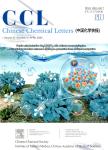Preparation of core-shell magnetic Fe_3O_4@SiO_2-dithiocarbamate nanoparticle and its application for the Ni^(2+), Cu^(2+) removal
Preparation of core-shell magnetic Fe_3O_4@SiO_2-dithiocarbamate nanoparticle and its application for the Ni^(2+), Cu^(2+) removal作者机构:School of Chemistry and Biological Engineering Hunan Provincial Key Laboratory of Materials Protection for Electric Power and Transportation Changsha University of Science and Technology
出 版 物:《Chinese Chemical Letters》 (中国化学快报(英文版))
年 卷 期:2018年第29卷第6期
页 面:887-891页
核心收录:
学科分类:081704[工学-应用化学] 07[理学] 070304[理学-物理化学(含∶化学物理)] 08[工学] 0817[工学-化学工程与技术] 070205[理学-凝聚态物理] 080501[工学-材料物理与化学] 0805[工学-材料科学与工程(可授工学、理学学位)] 0703[理学-化学] 0702[理学-物理学]
基 金:the financial support provided by the National Natural Science Foundation of China (No. 21671026) the Science and Technology Key Project of Hunan Province (No. 2015SK20823) Scientific Research Key Fund of Hunan Provincial Education Department (No. 15A001) the Foundation of Hunan Provincial Key Laboratory of Materials Protection for Electric Power and Transportation (No. 2017CL06)
主 题:Core-shell Magnetic nanoparticle Dithiocarbamate Adsorption Heavy metals removal
摘 要:A novel magnetic nanoparticles-based dithiocarbamate absorbent(Fe3O4@SiO2-DTC) with core-shell structure was synthesized under mild conditions and used in aqueous solution Ni2+ and Cu2+ ions treatment. The structure, morphology and magnetic properties of the adsorbent were characterized by Xray diffraction(XRD), fourier transformed infrared spectroscopy(FTIR), scanning electron microscopy(SEM), transmission electron microscopy(TEM), and vibrating sample magnetometer(VSM).Fe3O4@SiO2-DTC exhibited a typical superparamagnetic with a saturation magnetization value of52.7 emu/g, which could be rapidly separated from aqueous solution under external magnetic field. We investigated the effects of solution p H, adsorption time, and the initial concentration of heavy metal ions on the adsorption of Ni2+ and Cu2+. The adsorption equilibrium times of Ni2+and Cu2+ on Fe3 O4@SiO2-DTC were reached at 15 min and 90 min, respectively. The adsorption kinetic data were fitted to the pseudosecond-order model, and the adsorption data were consistent with the Frenudlich isotherm model. When the initial concentration of heavy metal ions was 250 mg/L, the maximum adsorption capacity of Ni2+ and Cu2+ at room temperature was 235.23 mg/g and 230.49 mg/g, respectively. In addition, we discussed the plausible adsorption mechanism. The results indicated that the adsorption was mainly dominated by chelation.



